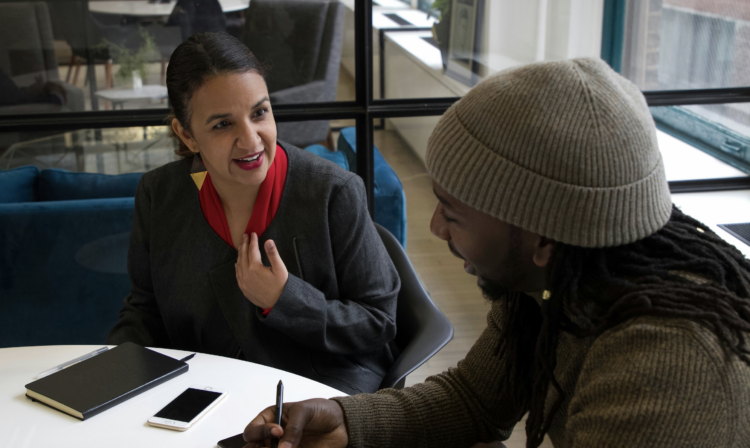Forming the partnership
Lauren Supplee (formerly of OPRE) and Charisse Johnson (formerly of OFA)
Many research-practice partnerships (RPP) begin when two initially unaffiliated partner organizations decide to pursue collaborative work. Having formed a partnership between our respective offices within a federal agency, our experience is a bit different. Still, the principles of effective partnering resound in our story, and may be helpful to new partnerships inside and outside government.
How it began
While at the Administration for Children and Families (ACF), a part of the federal Department of Health and Human Services, we worked, respectively, in the program office (i.e., the Office for Family Assistance, or OFA), which was charged with carrying out large and small grant programs, and the research office (i.e., the Office of Planning, Research, and Evaluation, or OPRE), which focused on research to assess and inform our work. Our research-practice partnership first took shape following the release of findings on the effectiveness of two OFA programs that OPRE had evaluated for nearly a decade
In the early 2000s, OPRE researchers launched two large random assignment evaluations to determine the extent to which OFA’s discretionary grant program to
promote healthy relationships between married and unmarried couples improved outcomes for low-income families. Ten years later, although there were some positive findings, the evaluation results were nevertheless disappointing. Even though we had a history of working together, mistrust and a misalignment of priorities now characterized the relationship between program and research offices. While OFA wanted to understand ways to improve programs, and while OPRE wanted to see research inform programming, we weren’t seeing eye to eye. It was then, as a response to these challenges, that we sought to develop joint priorities with shared goals.
With this, our research-practice partnership took shape.
Our first steps
The learning agenda
One of the foundational steps in our work was defining a mutual learning agenda for the partnership. A jointly defined, comprehensive, and cohesive learning agenda provided a template for the partnership to support the production and use of research evidence in the short- and long-term future. Our learning agenda was built through regular communication: OPRE would ask what questions OFA staff had and would seek to match those questions with what research could answer. Sometimes the answer was held in existing data; other times it meant a new research project.
One aspect of our learning agenda that illustrates joint development is performance measures. When OFA staff raised the issue that the performance measures at that time were not useful and were seen more as a paperwork exercise than supportive to the mission, OPRE responded. As a first step, OPRE facilitated discussions with OFA staff to build logic models for the relevant programs, which described the program activities and goals and aligned with ACF’s broader mission. OPRE also proposed new measures that better aligned with the logic models and provided information that was useful to federal staff and grantees. To respond to staff requests for data that was useful, the redesign included a new data system that allowed more direct access to data reports for federal staff and grantees to support their work.
The memorandum of understanding
With the learning agenda defined, OFA and OPRE developed an annual Memorandum of Understanding that codified shared commitments, stated OFA’s annual financial investment to support the joint activities, and outlined the year’s projects and how they would fit within larger goals. These memoranda were transparent in the kinds of projects proposed, the questions those projects would aim to answer, and the funds needed in the current and future years to execute the projects.
How it grew
Over time, OFA and OPRE staff became a joint team making shared decisions related to evidenced-informed and best practice thinking. The product of this effort was an environment of openness and transparency. Whereas in the past OPRE staff had not regularly engaged OFA staff in the research projects, thereby contributing to a lack of trust, as our work together progressed, OPRE began involving OFA staff on research calls for projects in the learning agenda, and OFA staff included OPRE staff on calls with grantees participating in research. For this sort of environment to flourish, leadership needs to allow the space for anyone to ask questions, be curious, and seek answers. Support from leadership can be critical to ensuring that the research-practice partnership is valued and integrated into the work on both sides. This means providing the necessary resources to support the partnership’s activities, including staff time and funding. This is no small ask, so keeping the partnership going requires that both sides understand the value of the investment.
Of course, when research and evaluation are integrated into the fabric of the program, it is easier to make the case for the partnership, for leadership understand its value, and for the work to be sustained. But what happens when staff change and move to new positions or leave the organization?
Sustaining the partnership
Seth Chamberlain (OFA) and Samantha Illangasekare (OPRE)
The value of RPPs can increase with each successive year, as long as they are sustained. Still, staff changes inevitably occur as partnerships age, and a primary challenge of moving the work forward is navigating these events and persisting through ongoing evolution.
A natural progression
As current staff at OFA and OPRE, we have had the first-hand opportunity to assume responsibility for the forward-thinking RPP that Ms. Johnson and Dr. Supplee created. In our time leading the partnership, it has matured in two notable ways. First, the RPP has broadened: The partnership now includes new staff at both OFA and OPRE, contractor teams who provide programmatic and evaluation-focused technical assistance to grantees, and a contractor team with expertise in implementation science. Second, the RPP has also increased its focus on using just-in-time data and short-term evaluation projects to quickly inform programming.
This more extensive, refocused collaboration represents a natural progression for healthy RPPs. As the partnerships rolls out, support increases and the purpose of the partnership is refined and redoubled. What’s more, the vision for the RPP creates a culture of collaboration that permeates the activities of partners on both sides. To sustain our momentum, we have memorialized our team, set structures in place to perpetuate collaboration, and begun new activities to intensify our RPP support to grantees.
Three keys for moving forward
- One key to maintaining forward momentum, particularly through periods of change, is to memorialize in writing the goals, structure, and creation process of the RPP. When leaders fail to document what they have created or the processes used to create it, the progress can be lost when the leaders move on. For example, we have begun to formalize one component of our RPP by creating an official “Implementation Team,” a core group of staff responsible for actively supporting implementation of programming using evidence and data. We expect all related grantee programs to have formalized Implementation Teams, which, in our work, have included program office leaders and staff, research office staff, and programmatic and research-focused technical assistance contractors. This core component to our work would potentially be lost in future iterations of the RPP if not for concretized documentation.
- A second key is to set structures in place for maintaining the RPP’s forward momentum. This most often takes the form of regular standing meetings. Standing meetings are especially useful if partners collaboratively develop an explicit purpose of the team and the meeting and include these at the top of each meeting agenda. This explicit statement of the purpose serves not just as a reminder to attendees, but also as an invitation to revisit and refine the goals and function of the team. Agendas should also include standing items to ensure that the team discusses key processes regularly. For example, in the technical assistance providers’ meeting agenda, we include standing items where each team provides an update on their activities and poses questions for the team. Separately, we have an annual celebration and reflection with federal program and research staff where we recall our successes in the past year, reflect on challenges, and forecast prospects in the next. Setting time aside offers opportunities for authentic reflection that we can use to refine our processes and agree to future directions.
- A third key is that all partners should remain open to engaging in new activities that can further the goals of the partnership. As an RPP, one of our primary goals is to encourage the use of data to improve programming in a timely way. As such, we have increased our attention to continuous quality improvement (CQI) by setting clearer CQI expectations for program grantees and providing more intensive CQI support. In recent months, program and research staff have collaborated to redefine and standardize the CQI process. We have created detailed guidance that grantees can use to implement their CQI processes. We are also offering direct CQI support to grantees by directing research contractor staff to work one-on-one with grantees to use data to tackle stubborn challenges. Separate from CQI, we are also engaging in new research approaches designed to produce quicker results (for example, rapid cycle evaluations) so that grantees have more timely rigorous data and can translate new knowledge more quickly into practice.
A lasting relationship
Having overseen programming and research for relationship education efforts, we’d be remiss not to end by highlighting that nurturing a research-practice partnership is not entirely different from nurturing any other close relationship.
When it comes to a healthy marriage, for instance, research points to the importance of principles like ensuring your partner knows you matter, being interested in what your partner cares about, and finding common ground, as well as basic appreciation and empathy. Similar to a marriage, a successful professional collaboration requires intentional efforts to build trust, transparency, and sustainability. A research-practice partnership involves not only initial investments and efforts to develop the relationship, but an active and ongoing commitment over time as people change positions or leave an organization entirely.
Like the best relationships, effective RPPs need to be mutually beneficial, committed, and trusting. It is vital to the health of the partnership that:
- Both partners see it as a joint priority with shared goals
- Both partners approach the work with an aim towards openness and transparency
- Both partners work to create a space for each to ask questions and be curious without judgement
- Both partners bring complementary strengths and resources to fill in gaps and bring different perspectives
Maintaining positive interpersonal relationships among collaborators is essential. We strengthen our relationships by regularly checking in on each other’s personal lives (sharing about our children/grandchildren is always a winner!). We also celebrate minor and major accomplishments: For example, after a successful conference, we like to share tokens of appreciation (usually made of chocolate). Strengthening our interpersonal relationships helps to foster an organic and inherent sense of team unity and solidifies our shared purpose and goals.
Importantly, all of the approaches that we have shared from our experience developing and sustaining our RPP—standardizing a memorandum of understanding, developing a joint learning agenda, formalizing the RPP, perpetuating it, being open to new activities, and strengthening interpersonal relationships—support the underlying goal of building trust. As with any other kind of partnership, trust is fortified when all partners are understanding, transparent, and open to change. Relationships form and deepen when partners value one another and are resolute and persistent in improving. Research-practice partnerships are no different.
Visit the Foundation’s Research-Practice Partnerships Website →





